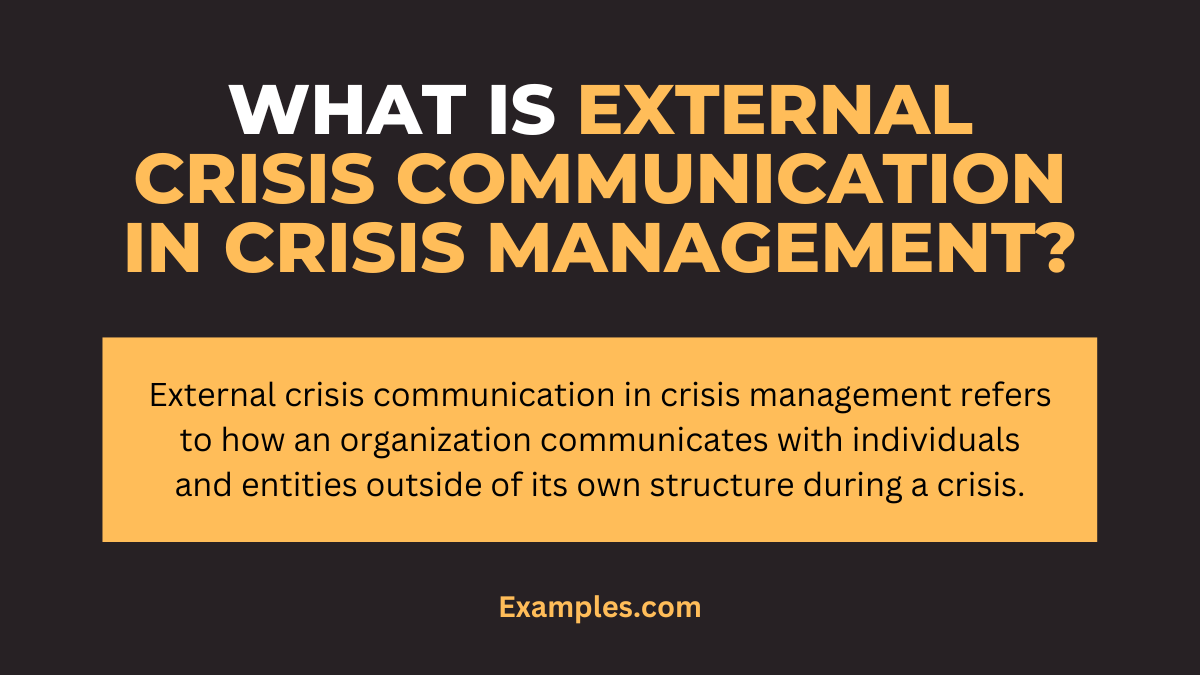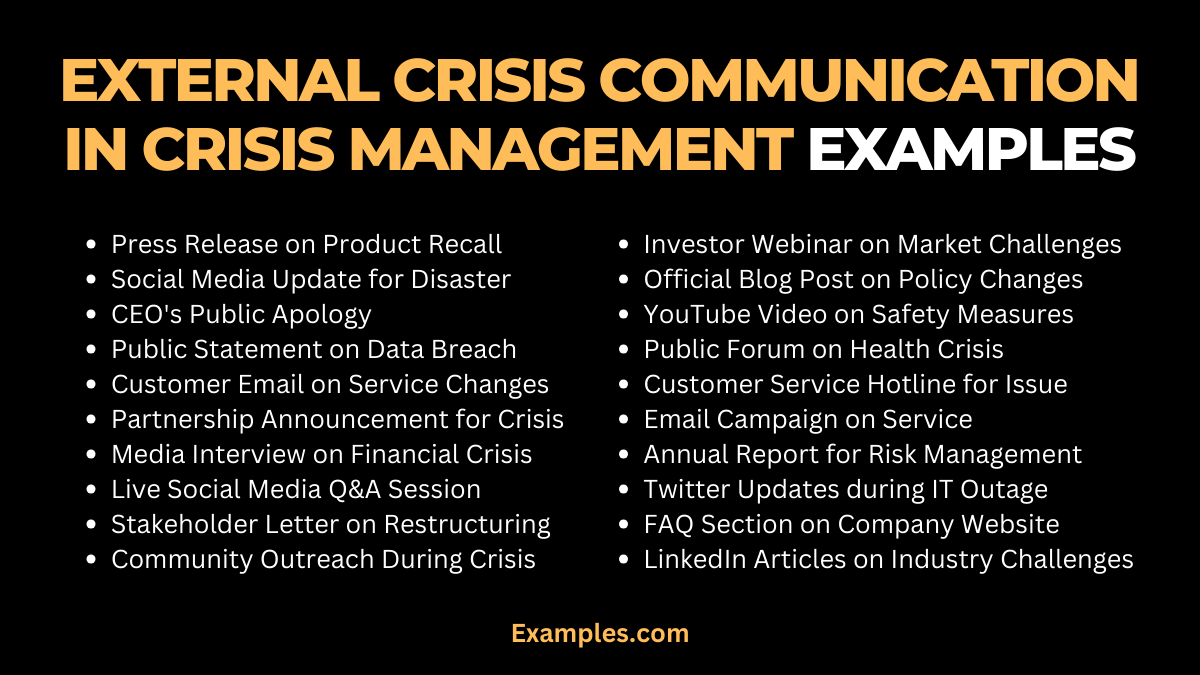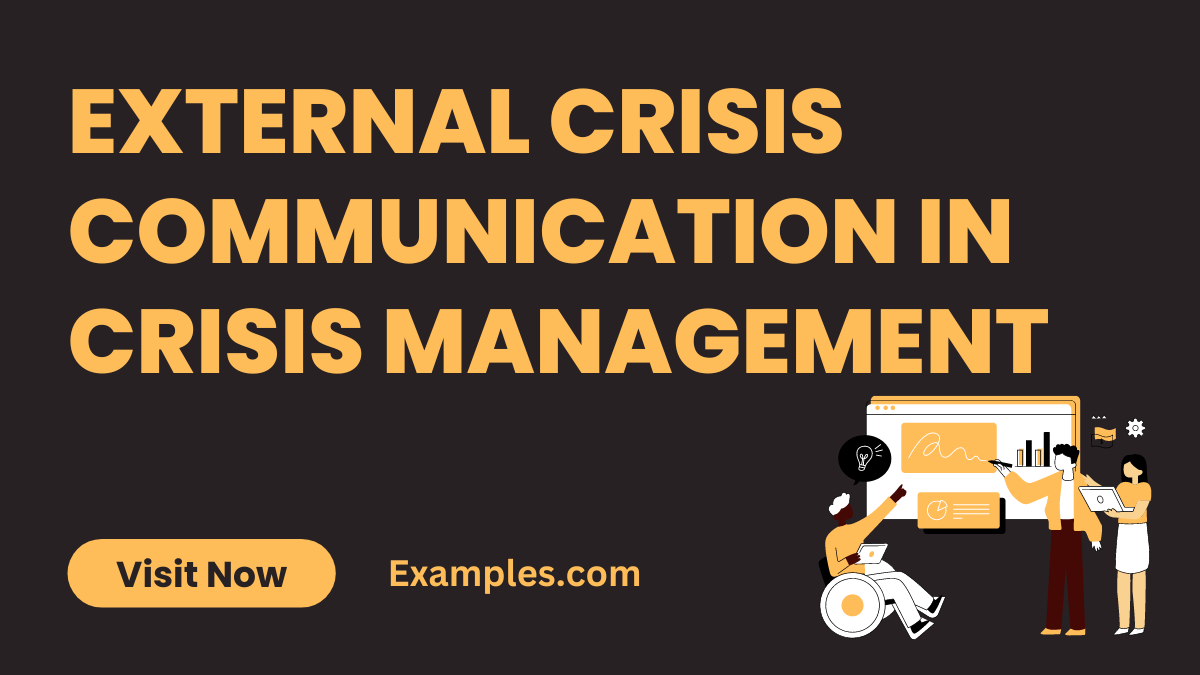19+ External Crisis Communication in Crisis Management Examples
Delve into the crucial role of external crisis communication. It outlines strategies and provides real-world examples to illustrate effective communication with external stakeholders during crises. Emphasizing the importance of transparency and timely updates, this guide serves as an essential resource for managing an organization’s external reputation and relationships in challenging times. Explore various case studies and expert insights to understand how proactive and reactive communication can mitigate risks and maintain public trust.
What is External Crisis Communication in Crisis Management?

External crisis communication in crisis management refers to how an organization communicates with individuals and entities outside of its own structure during a crisis. This includes communication with the public, media, customers, and other stakeholders. The focus is on providing accurate, timely information and maintaining the organization’s reputation. Effective external crisis communication can help in managing public perception and mitigating the impact of the crisis on the organization’s external relations.
20 External Crisis Communication in Crisis Management Examples

External Crisis Communication in Crisis Management involves strategically managing information and interactions with parties outside an organization during a crisis. This process is crucial for maintaining public trust, managing reputations, and ensuring accurate information dissemination. Effective external communication can mitigate the negative impacts of a crisis and facilitate a quicker resolution. It often involves addressing media, customers, partners, and the general public, using various channels such as press releases, social media, official statements, and media interviews.
- Press Release on Product Recall: A company issues a press release to inform the public about a voluntary product recall, emphasizing customer safety and providing clear instructions for returns.
- Social Media Update during Natural Disaster: A utility company uses social media to provide real-time updates on service restoration efforts after a natural disaster, ensuring customers are informed and reassured.
- CEO’s Public Apology: Following a service outage, a company’s CEO issues a public apology via a video message, acknowledging the issue and outlining steps to prevent future occurrences.
- Public Statement on Data Breach: A tech company issues a public statement about a data breach, detailing the breach’s extent and the measures taken to secure user data.
- Customer Email on Service Changes: An airline sends emails to customers about changes in flight schedules due to unforeseen circumstances, offering rebooking options and refunds.
- Partnership Announcement during Supply Chain Crisis: A manufacturer announces a new partnership to address supply chain disruptions, demonstrating proactive steps to resolve the issue.
- Media Interview on Financial Crisis: A financial institution’s spokesperson addresses concerns in a media interview during a financial crisis, providing clarity and assurance to stakeholders.
- Live Social Media Q&A Session: A company hosts a live Q&A session on social media to address customer concerns and clarify misunderstandings during a product controversy.
- Stakeholder Letter on Corporate Restructuring: A CEO sends a detailed letter to stakeholders explaining the reasons and expected outcomes of a corporate restructuring process.
- Community Outreach during Environmental Crisis: A company involved in an environmental crisis engages in community outreach programs to repair damage and rebuild community trust.
- Investor Webinar on Market Challenges: An organization hosts a webinar for investors to discuss market challenges and strategic responses, ensuring transparency and confidence.
- Official Blog Post on Policy Changes: Following regulatory changes, a company uses its official blog to explain the new policies and their impact on customers.
- YouTube Video on Safety Measures: A construction company releases a video detailing new safety measures implemented after an onsite accident, showing commitment to employee welfare.
- Public Forum on Health Crisis: A healthcare organization holds a public forum to discuss its response to a health crisis, providing experts’ insights and answering community questions.
- Customer Service Hotline during Product Issue: A company sets up a dedicated hotline to address customer concerns during a product issue, providing personalized support and solutions.
- Email Campaign on Service Improvements: Post-crisis, a service provider launches an email campaign detailing improvements made to prevent future issues, rebuilding customer confidence.
- Annual Report Highlighting Risk Management: A company’s annual report includes a section on crisis management and risk mitigation strategies, showcasing its commitment to resilience and stability.
- Twitter Updates during IT Outage: An IT company uses Twitter to provide frequent updates during a system outage, keeping users informed about resolution progress.
- FAQ Section on Company Website: In response to recurring customer queries during a crisis, a company updates its website’s FAQ section to provide clear, accessible information.
- LinkedIn Articles on Industry Challenges: A company uses LinkedIn to publish articles addressing industry challenges and its strategic responses, positioning itself as a thought leader.
What is the Role of External Crisis Communication in Crisis Management?
- Introduction to External Crisis Communication: Understand the significance of external crisis communication in managing a crisis effectively.
- Establishing Trust and Transparency: Explore how external communication builds trust and transparency with stakeholders.
- Key External Stakeholders: Identify the primary external stakeholders involved in crisis communication, including customers, investors, media, and regulatory bodies.
- Risk Mitigation and Reputation Management: Learn how external crisis communication helps in mitigating risks and protecting the organization’s reputation.
- Real-Time Updates and Information Dissemination: Discuss the role of providing real-time updates and disseminating accurate information during a crisis.
- Legal and Regulatory Compliance: Learn about the legal and regulatory aspects of external crisis communication.
- Social Media and Online Presence: Discuss the role of social media and online presence in external crisis communication.
What are the Strategies of External Crisis Communication in Crisis Management?
- Media Engagement Strategy: Develop a robust media engagement plan that includes designated spokespersons, press releases, and media briefings to ensure accurate information reaches the public swiftly.
- Stakeholder Communication: Identify key stakeholders, including customers, investors, and partners, and establish clear lines of communication to keep them informed about the crisis and its impact.
- Social Media Management: Create a social media strategy that involves real-time updates, responding to inquiries, and addressing concerns promptly on various social platforms.
- Website Crisis Page: Designate a crisis-specific page on your website to provide accurate information, FAQs, and contact details for concerned parties.
- Message Consistency: Ensure consistent messaging across all external communications to avoid confusion and misinformation.
- Community Engagement: Engage with the affected community through outreach programs, town hall meetings, and initiatives that demonstrate your commitment to resolving the crisis’s impact.
- Monitoring and Adjustments: Continuously monitor the effectiveness of your external communication strategies and be prepared to make adjustments based on feedback and changing circumstances.
How to Communicate with External Stakeholders during Crisis Management?
- Preparing a Crisis Communication Plan: Understand the importance of having a well-defined crisis communication plan in place.
- Segmenting External Stakeholders: Learn how to categorize and prioritize external stakeholders based on their impact and influence.
- Choosing Communication Channels: Explore the various communication channels available for reaching external stakeholders, including press releases, social media, emails, and press conferences.
- Crafting Clear and Consistent Messages: Understand the art of crafting clear, concise, and consistent messages that resonate with external stakeholders.
- Timely Communication: Discuss the significance of timely communication to prevent misinformation and rumors.
- Monitoring and Response: Learn how to monitor external conversations and respond proactively to emerging issues.
- Post-Crisis Evaluation: Discuss the importance of evaluating external crisis communication efforts post-crisis for learning and improvement.
These comprehensive guides will help organizations navigate external crisis communication effectively, ensuring they maintain trust and credibility with their external stakeholders during challenging times.
Tips for Incorporating External Crisis Communication in Crisis Management
- Preparation Is Key: Develop a crisis communication plan well in advance to ensure a swift response when a crisis arises.
- Designate Spokespersons: Clearly designate and train spokespersons who are capable of delivering consistent and empathetic messages to the public and media.
- Listen Actively: Pay close attention to social media, news outlets, and feedback from stakeholders to understand public sentiment and address concerns promptly.
- Empathetic Communication: Show empathy and understanding in your external communications, acknowledging the impact of the crisis on individuals and communities.
- Open Channels of Communication: Establish multiple channels, such as hotlines, social media, and dedicated email addresses, for affected parties to reach out and receive information.
- Regular Updates: Provide regular updates to keep stakeholders informed about the evolving situation and the steps being taken to resolve it.
Incorporating these strategies and tips into your external crisis communication plan can help your organization navigate challenging situations while preserving trust and reputation.
In conclusion, external crisis communication in crisis management plays a pivotal role in preserving reputation and trust. Effective strategies, such as media engagement, transparency, and stakeholder communication, are essential for navigating challenging times. By embracing these practices and maintaining message consistency, organizations can demonstrate resilience and commitment to resolution, ultimately strengthening their bonds with the public and stakeholders.



